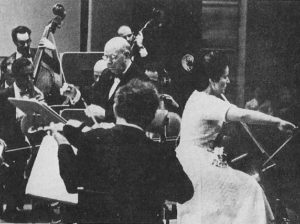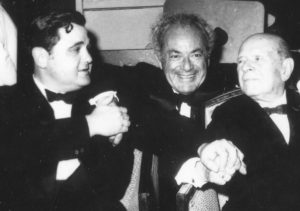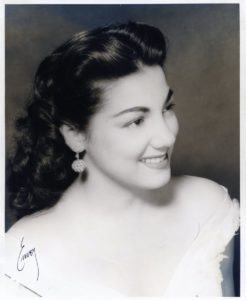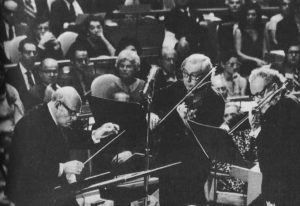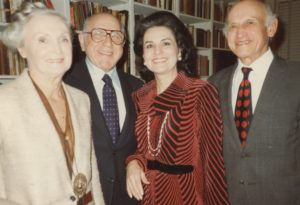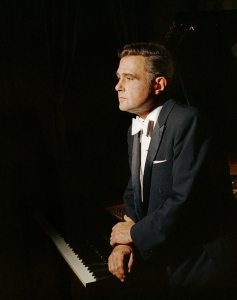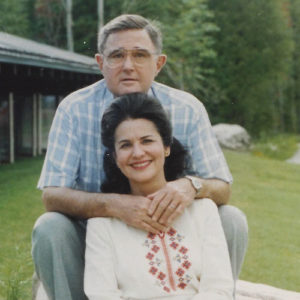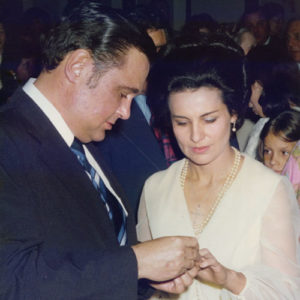 To all appearances, Eugene Istomin was a confirmed bachelor and was always extremely discreet about his private life. In John Gruen’s long interview for The New York Times in 1971, he was very reluctant to comment on it, simply explaining that he loved being alone, and that his life was so full that it would be unreasonable to share it or to start a family. His concerts would only have allowed him to spend about fifty days at home each year, and his numerous passions for literature, art or baseball, not to mention his political commitments, completely fulfilled his life. Nevertheless, on February 4, 1975, The New York Times announced his marriage to Marta Casals. Leslie Maitland had interviewed the couple and her article began as follows: ‘’Eugene Istomin, the pianist whom Pablo Casals called ‘my son’, and Martita Montañez Casals, widow of the Spanish cellist-composer, announced yesterday that they would marry – twice, once in English, once in Spanish – within the next few weeks. They have known each other for 25 years.’’
To all appearances, Eugene Istomin was a confirmed bachelor and was always extremely discreet about his private life. In John Gruen’s long interview for The New York Times in 1971, he was very reluctant to comment on it, simply explaining that he loved being alone, and that his life was so full that it would be unreasonable to share it or to start a family. His concerts would only have allowed him to spend about fifty days at home each year, and his numerous passions for literature, art or baseball, not to mention his political commitments, completely fulfilled his life. Nevertheless, on February 4, 1975, The New York Times announced his marriage to Marta Casals. Leslie Maitland had interviewed the couple and her article began as follows: ‘’Eugene Istomin, the pianist whom Pablo Casals called ‘my son’, and Martita Montañez Casals, widow of the Spanish cellist-composer, announced yesterday that they would marry – twice, once in English, once in Spanish – within the next few weeks. They have known each other for 25 years.’’
It was true that Marta and Eugene had first met in July 1951 at the Perpignan Festival. Marta had come from Puerto Rico with her uncle to audition for Casals. She remembers attending a rehearsal where Casals conducted and Istomin was the soloist: “Eugene played Mozart’s Concerto No. 14, and everyone was thrilled. There was a passage that he played so well that Casals nodded his head at Sasha Schneider and mumbled ‘Ah! Beautiful…”. I had asked the name of the young pianist, I thought that he played wonderfully well, and he was cute. I was fourteen years old!” Stendhal, one of Eugene’s favorite authors, would probably say that this was the very first step of the crystallization!
Casals considered that Marta was very talented. He said that when her teacher, Lieff Rosanoff, felt she was ready, he would be happy to welcome her to Prades and teach her. Marta arrived in November 1954 at a very difficult moment for Casals. His companion Frasquita Capdevila was gravely ill, and died in January. Marta began her education under Casals and attended the 1955 festival. Istomin, who assumed the artistic direction along with Madeline Foley, participated in six concerts. Marta had been introduced to him but, intimidated by this great artist, she did not dare to engage in conversation. She heard of the anger between Casals and Istomin at the end of the festival, but she soon learned about their reconciliation and was aware of the unfailing affection that united them. As for Eugene, he became aware of Marta’s strong personality at the first Puerto Rico Festival in 1957, when she took charge of the situation after Casals’ heart problems.
When Marta married Casals a few months later, which caused some controversy, she felt how deeply Eugene rejoiced in their marriage. He had described his own meeting with Casals as love at first sight. If there were anyone who could understand how a young woman like Marta could fall in love with Casals, it was him!
Thereafter, Istomin and Marta rarely saw each other again, mainly only during the turmoil of the Puerto Rico festivals. Marta remembers great moments of music, especially the Schumann Concerto. Istomin played it beautifully in October 1958 with the New York Philharmonic under Leonard Bernstein at Carnegie Hall. Marta attended, as she was in New York with Casals who participated for the first time in the United Nations concert. Istomin played it again even more impressively in Puerto Rico the following year under Schneider. There were also the regular visits Istomin paid to Casals. Marta was very happy to see him come because the atmosphere was particularly relaxed. Istomin and Casals always embarked upon long conversations and made music together, which allowed Marta to go shopping or to visit her family.
When Casals became seriously ill in October 1973 with a lung infection that soon forced him to wear an oxygen mask, Istomin visited him as often as he could. At one time, Casals spoke about his concern regarding Marta’s future. It was a delicate way of asking him to look after her, which Istomin took to heart. After Casals’ death, all their friends called Marta regularly to check in with her and offer their help, but inevitably, the calls gradually tapered off, except for Istomin’s. Even if he was on the other end of the world, he remained faithful to the tacit promise he had made to Casals. He not only worried about the burden of Marta’s loneliness, but also about the weight of her responsibilities, as she was simulteanously managing the Casals Festival, the Puerto Rico Symphony Orchestra and the Conservatory, the three institutions which she had founded with Casals. She was also in charge of Casals’ musical and human legacy. Marta became accustomed to asking Istomin for advice, as his ideas were insightful. This led to a sense of complicity which developed over time, although they rarely saw each other because Marta lived and worked in Puerto Rico, while Istomin was travelling all over the world concertizing.
In early July 1974, Marta was due to go to Marlboro for a tribute to Casals. She was accompanied by her lifelong friend, the great Puerto Rican soprano Olga Iglesias, who was scheduled to sing some songs by Casals there. They first stopped in New York where Marta had several problems to clear up. Istomin was in town and they agreed to meet. Aware of the evolution of his feelings for Marta, and encouraged by his friend Vladimir Brailovsky, who thought that Marta would be the ideal wife for him, Eugene invited Marta to dinner and dared to declare his love. Marta’s answer was kindly discouraging: ”Oh, how sweet of you, but for now, you know, I’m not really ready for anything like that!’’ Eugene did not take offence, and said that he understood and didn’t want to pressure her. When Marta arrived at her hotel, Olga was not asleep and Marta told her about the dinner. They spent most of the night talking. Olga was not surprised: “Seeing the way he looks at you, I knew it!” She was very enthusiastic, as she liked Istomin immensely and thought that this union was perfectly natural, and urged Marta to reconsider his proposal! .
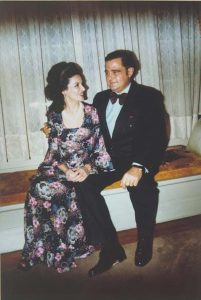 On returning from Marlboro, Marta and Istomin briefly met again and realized that they were going to be in Paris at the same time, at the end of August. Istomin had concerts in Europe and Marta was going to Prades to sort out all the belongings and documents which had been left in the house in Molitg since 1966, the last year she and Casals had been there. She also had to go to Geneva to meet Alberto Ginastera from whom she had commissioned a work for the Puerto Rico Festival. Eugene and Marta met for a few days in Paris, sharing as much time together as possible going for walks, visiting museums, and talking a lot. The nature of their relationship soon evolved, and they realized that they were indeed made for each other. However, they remained very discreet: Casals had been dead for less than a year and seeing the two of them together could lead to malicious gossip. They had a strong feeling that Casals would be very happy with their union, but they decided to keep it a secret as long as possible and reveal it only to very close friends. When Istomin had given his last concert and Marta had packed up everything in Molitg, they went to Marseille to visit Alexander Schneider at his home in Le Paradou, not far from Les Baux-de-Provence. Marta had told him that she would not be coming alone, but that she wanted to keep it a surprise. Sasha was astonished to see that she was accompanied by Istomin, and was so taken aback that he dared not ask any questions! In the end, it was Istomin who had to broach the issue, while Marta confirmed that they had decided to marry. Only then did Sasha emerge from his daze to say: “I am happy for you!’”
On returning from Marlboro, Marta and Istomin briefly met again and realized that they were going to be in Paris at the same time, at the end of August. Istomin had concerts in Europe and Marta was going to Prades to sort out all the belongings and documents which had been left in the house in Molitg since 1966, the last year she and Casals had been there. She also had to go to Geneva to meet Alberto Ginastera from whom she had commissioned a work for the Puerto Rico Festival. Eugene and Marta met for a few days in Paris, sharing as much time together as possible going for walks, visiting museums, and talking a lot. The nature of their relationship soon evolved, and they realized that they were indeed made for each other. However, they remained very discreet: Casals had been dead for less than a year and seeing the two of them together could lead to malicious gossip. They had a strong feeling that Casals would be very happy with their union, but they decided to keep it a secret as long as possible and reveal it only to very close friends. When Istomin had given his last concert and Marta had packed up everything in Molitg, they went to Marseille to visit Alexander Schneider at his home in Le Paradou, not far from Les Baux-de-Provence. Marta had told him that she would not be coming alone, but that she wanted to keep it a surprise. Sasha was astonished to see that she was accompanied by Istomin, and was so taken aback that he dared not ask any questions! In the end, it was Istomin who had to broach the issue, while Marta confirmed that they had decided to marry. Only then did Sasha emerge from his daze to say: “I am happy for you!’”
Marta and Eugene left, with Marta returning to Puerto Rico and Eugene beginning his American season. A few weeks later, they joined each other in New York, with the intention of letting Isaac and Vera Stern in on the secret. A lunch was arranged at the Stern’s residence. Eugene arrived with Marta, which hardly surprised Isaac, who was very happy to see her. On several occasions, Eugene tried to move on to the topic of marriage, but each time he had barely started his sentence when the phone rang – and when it wasn’t the phone, it was the children who interrupted with an urgent question. Isaac’s usual life! Lunch came to an end, and Eugene and Marta left without being able to announce the news. When they got back in the car, they broke into gales of laughter! The next day a rueful Isaac phoned. Sasha had just called to tell him the news…
January 1975 marked the celebration of the 100th anniversary of Albert Schweitzer’s birth. Marta and Eugene were both associated with this event. Even though they had only met a few times, Casals and Schweitzer had always been very friendly. Marta was a member of the committee that awarded the first Albert Schweitzer Prize to Isaac Stern. The award was presented to him by Andrés Segovia and Leonard Bernstein at a tribute concert at Carnegie Hall in which Eugene and several other great musicians participated. At this point, Marta and Eugene came to the conclusion that it was better to marry than to live in hiding, and they decided to do so as soon as possible. The only possible date left in Eugene’s calendar was February 15. Marta had not yet told her parents and she took Eugene to Puerto Rico immediately. This time, Marta’s delighted parents gave their blessing without hesitation.
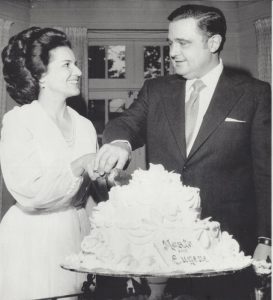 In the interview published by The New York Times, Eugene explained that after Casals’ death two years ago, “solicitude and care turned to something else” and that it was “really too mysterious to describe how love came about.” He added that he already had the feeling that they were “forming a unity together.” Marta said that they shared a great deal in common. “We will work to bring to life and light the things that Maestro Casals left to us – the museums, the festivals. That will be a very important part of our lives.” Both of them were still amazed to have found each other. Eugene felt that by not marrying earlier he had somehow been “preserved or saved or spared for the right person.” And Marta considered that after ‘’having had such a rich, wonderful life with Casals, (she) feels very lucky to have found Eugene now.” .
In the interview published by The New York Times, Eugene explained that after Casals’ death two years ago, “solicitude and care turned to something else” and that it was “really too mysterious to describe how love came about.” He added that he already had the feeling that they were “forming a unity together.” Marta said that they shared a great deal in common. “We will work to bring to life and light the things that Maestro Casals left to us – the museums, the festivals. That will be a very important part of our lives.” Both of them were still amazed to have found each other. Eugene felt that by not marrying earlier he had somehow been “preserved or saved or spared for the right person.” And Marta considered that after ‘’having had such a rich, wonderful life with Casals, (she) feels very lucky to have found Eugene now.” .
The wedding took place at Silvia Furhman’s home, a close collaborator of the Secretary General of the United Nations whom Marta had met in 1971, when Casals received the UN Peace Medal. Silvia Furhman was to remain a lifelong friend of the Istomins. Eugene had stated that it would be a marriage without fuss, only for family and intimate friends. There were about fifty guests, including Gary Graffman and Leonard Rose (Isaac Stern was on tour). Eugene chose his old friend Vladimir Brailovsky as best man. After the ceremony and buffet, Eugene and Marta went to Avery Fischer Hall to hear Claude Frank play the Beethoven Third Concerto with the New York Philharmonic Orchestra conducted by Rafael Kubelik. .
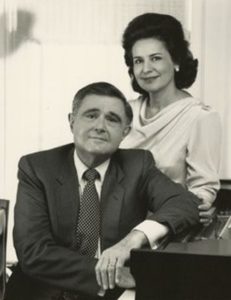 Marta left Puerto Rico for New York and moved to Mayflower, first into Eugene’s apartment and then to a duplex on the 18th floor, which had once been occupied by Rudolf Valentino and which offered a superb view of Central Park. Marta continued to run the Puerto Rican institutions, making frequent round trips, and accompanied Eugene on tour as often as she could. This marriage profoundly changed the course of their lives and brought deep happiness to both of them, with an exceptional complicity of thoughts and feelings. Marta used to say that what one felt, the other felt in exactly the same way! If they ever had a dispute on any subject, they decided not to let the disagreement fester in their minds, and worked to resolve it as quickly as possible. They had similar ideas on political issues, with Marta being the more optimistic one. The only area where they did not match was religion. Marta was a devout Catholic, whereas Eugene had dismissed the religions of his parents (Orthodox and Jewish). As he was highly interested in the history of religions, he had built up a kind of ecumenical faith which did not need worship. They often talked about it, and Marta felt that Eugene had gradually come closer to Catholicism. They shared many happy moments. Marta’s good mood was contagious, and her talent for imitating everyone was amazing! Eugene had a strong sense of humor, including self-mockery.
Marta left Puerto Rico for New York and moved to Mayflower, first into Eugene’s apartment and then to a duplex on the 18th floor, which had once been occupied by Rudolf Valentino and which offered a superb view of Central Park. Marta continued to run the Puerto Rican institutions, making frequent round trips, and accompanied Eugene on tour as often as she could. This marriage profoundly changed the course of their lives and brought deep happiness to both of them, with an exceptional complicity of thoughts and feelings. Marta used to say that what one felt, the other felt in exactly the same way! If they ever had a dispute on any subject, they decided not to let the disagreement fester in their minds, and worked to resolve it as quickly as possible. They had similar ideas on political issues, with Marta being the more optimistic one. The only area where they did not match was religion. Marta was a devout Catholic, whereas Eugene had dismissed the religions of his parents (Orthodox and Jewish). As he was highly interested in the history of religions, he had built up a kind of ecumenical faith which did not need worship. They often talked about it, and Marta felt that Eugene had gradually come closer to Catholicism. They shared many happy moments. Marta’s good mood was contagious, and her talent for imitating everyone was amazing! Eugene had a strong sense of humor, including self-mockery.
Already, the marriage had contributed to an acceleration of Eugene’s reflecting upon his present lifestyle. He was aware that he was overweight, and on several occasions, had embarked on draconian, unreasonable and quickly renounced diets. This time, he undertook to lose weight methodically and forced himself into exercising on a regular basis by walking, running and swimming. He lost about thirty pounds and was able to stay at a reasonable weight. As a consequence, he had to completely replace his wardrobe and gave his former one to a fellow pianist.
Eugene never consumed alcohol during the day, but he enjoyed drinking good wine for dinner. Above all, he enjoyed spending long nights talking and drinking when he met up with great friends (especially Arikha!). He admitted to the excesses of this period and had reduced them from the early 1970s, after finding it increasingly difficult to practice the next morning. After his marriage, Eugene completely abandoned these drunken nights. Each evening, he carried out the rite of his “Martini”, which was meticulously prepared in a glass full of ice with a very good gin (Beefeater or Tanqueray), a shot of Vermouth, and a sliver of lime. Watching him prepare his martini was a special experience, and sharing a drink with him was even more enjoyable! It was his way of escaping from the tensions of the day before having dinner with friends or immersing himself in reading. Eugene also reduced his tobacco consumption. He switched to “light” cigarettes, which he hated, smoking one at the end of meals, and lighting a few others during the day without smoking them. In the early 1980s, after a bout of the flu, he stopped completely.
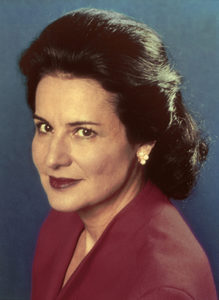 Marta never intervened in these efforts, even if her love and presence were a great encouragement. Eugene never regretted his diehard bachelor habits! He discovered the formerly unknown pleasure of staying at home, even concerning himself with the decor. He only spent about fifty days a year at home and was determined to make the most of them. As for Marta, she joined him on tour whenever she could, never missing an important concert, even when she had heavy responsibilities. She also learned some of the mysteries of baseball and accompanied Eugene to the stadium.
Marta never intervened in these efforts, even if her love and presence were a great encouragement. Eugene never regretted his diehard bachelor habits! He discovered the formerly unknown pleasure of staying at home, even concerning himself with the decor. He only spent about fifty days a year at home and was determined to make the most of them. As for Marta, she joined him on tour whenever she could, never missing an important concert, even when she had heavy responsibilities. She also learned some of the mysteries of baseball and accompanied Eugene to the stadium.
To Marta, Eugene brought his energy, his ability to listen and reflect, a constant sense of curiosity, an immense culture, and his talent as a musician. He helped to build up her self-confidence and encouraged her to take up the major professional challenges that she faced over the years, from the Executive Committee of Harcourt Brace and Jovanovich Editions to the presidency of the Manhattan School of Music. When Marta, not without hesitation, accepted the artistic direction of the Kennedy Center for the Performing Arts, Eugene immediately decided to leave his beloved New York in order to move to Washington. Marta could always rely on his ideas and vision, which she considered to be broader than her own, and even his writing skills when it was useful. However, he remained strictly in the role of an advisor, leaving her free to make her own decisions.
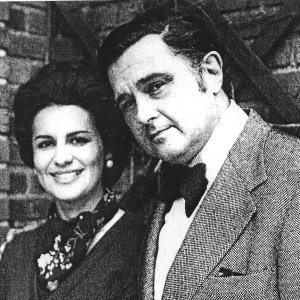 Marta brought to Eugene love, understanding, and a complicity that he had never experienced before. There was also a certain serenity too, which compensated for some of the “tortured and enigmatic” sides of his personality, in John Gruen’s words. Their musical ideas were naturally very close, as Marta was herself a musician and had been taught by Casals! Experiencing this concurrence of similar ideas was invaluable to him, whether it concerned his own performances or musical life in general. Marta never made any comments or suggestions about his playing. At most, she pointed out that the tempo, phrasing or color of various passages were not quite the same as at previous concerts. Occasionally, when he was practicing and she was there, he would ask her to sit down and listen. They did not really need to talk – Eugene guessed what she felt, and it was enough for him. .
Marta brought to Eugene love, understanding, and a complicity that he had never experienced before. There was also a certain serenity too, which compensated for some of the “tortured and enigmatic” sides of his personality, in John Gruen’s words. Their musical ideas were naturally very close, as Marta was herself a musician and had been taught by Casals! Experiencing this concurrence of similar ideas was invaluable to him, whether it concerned his own performances or musical life in general. Marta never made any comments or suggestions about his playing. At most, she pointed out that the tempo, phrasing or color of various passages were not quite the same as at previous concerts. Occasionally, when he was practicing and she was there, he would ask her to sit down and listen. They did not really need to talk – Eugene guessed what she felt, and it was enough for him. .
Before and after an important concert, Marta’s presence was essential. She understood his stage fright, the difficulties, the ideal he was striving for which was so difficult to achieve. Eugene was so rarely satisfied with his performances! Marta managed to temper this cruel feeling of imperfection. She never actively managed his career, but simply helped him with administrative tasks and followed up on letters and phone messages when Eugene was on tour, ensuring that no information was lost. When Marta was in charge of the Kennedy Center, she was in continuous contact with managers and conductors and could have facilitated engagements, but Eugene absolutely refused, even asking her to space out his concerts at the Kennedy Center or the Evian Festival (which Marta managed from 1990). Both were imbued with the same sense of moral rectitude and a refusal to compromise.
Eugene shared many projects with Marta, from their collaboration with HBJ, when Eugene became a special advisor to the president of the publishing group, until the Manhattan School of Music, when Eugene agreed for the first time to teach on a regular basis. They took great pains to preserve Casals’ musical and humanist legacy. For the centenary of his birth in 1976, they organized or participated in a number of events all over the world. They invited Mstislav Rostropovich to Puerto Rico, and established a very deep friendship with him. Eugene volunteered to run a Casals Festival in Mexico, a fantastic initiative that would have boosted local musical life, but unfortunately the next President of the Mexican Republic decided to stop the project. Eugene never ceased to stand by Marta’s side in support of the Casals Foundation up until the re-inauguration of the beautifully restored El Vendrell Museum in 2001, which took place in the presence of the King of Spain. .
Without Marta, the last thirty years of Eugene’s life would have been infinitely less happy. The course of the world, both internationally and in his own country, made him increasingly pessimistic, and the decline of cultural life due to the influence of marketing and profit drove him to despair. His own career was damaged by this decline, and in the end, the expected recognition, which appeared to be imminent several times, never materialized. Marta understood this all too well and was able to soften this frustration, which greatly helped Eugene to distance himself and put things into perspective.
When Eugene’s liver cancer broke out and proved to be incurable, Marta’s support was total. Eugene faced his illness with great courage and dignity. Following the example of his father, who had chosen to be buried in a Jewish cemetery in order for his wife to join him one day, Eugene wished to lie in El Vendrell, not far from Casals’ grave, so that Marta could one day be close to the two men whose lives she had shared.

